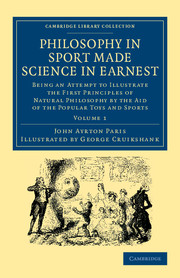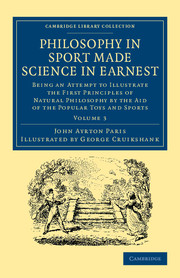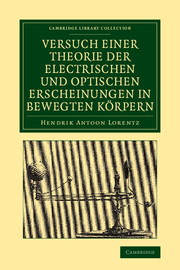Refine search
Actions for selected content:
12661 results in History of science
LIVRE III - L'Age primaire
-
- Book:
- Le monde avant la création de l'homme
- Published online:
- 05 November 2014
- Print publication:
- 17 April 2014, pp 253-254
-
- Chapter
- Export citation
PLACEMENT DES PLANCHES DANS CETTE ÉDITION
-
- Book:
- Le monde avant la création de l'homme
- Published online:
- 05 November 2014
- Print publication:
- 17 April 2014, pp 847-847
-
- Chapter
- Export citation
Chapitres III - La période crétacée
-
- Book:
- Le monde avant la création de l'homme
- Published online:
- 05 November 2014
- Print publication:
- 17 April 2014, pp 607-644
-
- Chapter
- Export citation
Physiological History of Digestion
-
- Book:
- A Treatise on Diet
- Published online:
- 05 November 2014
- Print publication:
- 17 April 2014, pp 48-76
-
- Chapter
- Export citation
Sect. V - The Kidneys
-
- Book:
- A Treatise on Diet
- Published online:
- 05 November 2014
- Print publication:
- 17 April 2014, pp 44-45
-
- Chapter
- Export citation
Chapitres II - La formation du système solaire
-
- Book:
- Le monde avant la création de l'homme
- Published online:
- 05 November 2014
- Print publication:
- 17 April 2014, pp 48-63
-
- Chapter
- Export citation
Frontmatter
-
- Book:
- A Treatise on Diet
- Published online:
- 05 November 2014
- Print publication:
- 17 April 2014, pp i-iv
-
- Chapter
- Export citation

Philosophy in Sport Made Science in Earnest
- Being an Attempt to Illustrate the First Principles of Natural Philosophy by the Aid of the Popular Toys and Sports
-
- Published online:
- 05 April 2014
- Print publication:
- 18 April 2013
- First published in:
- 1827

Philosophy in Sport Made Science in Earnest
- Being an Attempt to Illustrate the First Principles of Natural Philosophy by the Aid of the Popular Toys and Sports
-
- Published online:
- 05 April 2014
- Print publication:
- 18 April 2013
- First published in:
- 1827

Philosophy in Sport Made Science in Earnest
- Being an Attempt to Illustrate the First Principles of Natural Philosophy by the Aid of the Popular Toys and Sports
-
- Published online:
- 05 April 2014
- Print publication:
- 18 April 2013
- First published in:
- 1827

Bija Ganita; or, the Algebra of the Hindus
-
- Published online:
- 05 April 2014
- Print publication:
- 28 February 2013
- First published in:
- 1813

Versuch einer Theorie der electrischen und optischen Erscheinungen in bewegten Körpern
-
- Published online:
- 05 April 2014
- Print publication:
- 31 October 2013
- First published in:
- 1895
PARS II - PHYSICA
-
- Book:
- Catalogus bibliothecæ historico-naturalis Josephi Banks
- Published online:
- 05 November 2014
- Print publication:
- 27 March 2014, pp 370-498
-
- Chapter
- Export citation
PARS II - HISTORIÆ NATURALIS SCRIPTORES GENERALES
-
- Book:
- Catalogus bibliothecæ historico-naturalis Josephi Banks
- Published online:
- 05 November 2014
- Print publication:
- 27 March 2014, pp 165-301
-
- Chapter
- Export citation
Frontmatter
-
- Book:
- Catalogus bibliothecæ historico-naturalis Josephi Banks
- Published online:
- 05 November 2014
- Print publication:
- 27 March 2014, pp i-ii
-
- Chapter
- Export citation
1 - Encomia Botanices
-
- Book:
- Catalogus bibliothecæ historico-naturalis Josephi Banks
- Published online:
- 05 November 2014
- Print publication:
- 27 March 2014, pp 1-360
-
- Chapter
- Export citation
PARS IV - ŒCONOMICA
-
- Book:
- Catalogus bibliothecæ historico-naturalis Josephi Banks
- Published online:
- 05 November 2014
- Print publication:
- 27 March 2014, pp 518-569
-
- Chapter
- Export citation
Contents
-
- Book:
- Catalogus bibliothecæ historico-naturalis Josephi Banks
- Published online:
- 05 November 2014
- Print publication:
- 27 March 2014, pp iii-x
-
- Chapter
- Export citation
ADDENDA
-
- Book:
- Catalogus bibliothecæ historico-naturalis Josephi Banks
- Published online:
- 05 October 2014
- Print publication:
- 27 March 2014, pp 525-531
-
- Chapter
- Export citation
Bibliothecæ Zoologicæ
-
- Book:
- Catalogus bibliothecæ historico-naturalis Josephi Banks
- Published online:
- 05 November 2014
- Print publication:
- 27 March 2014, pp 1-369
-
- Chapter
- Export citation
